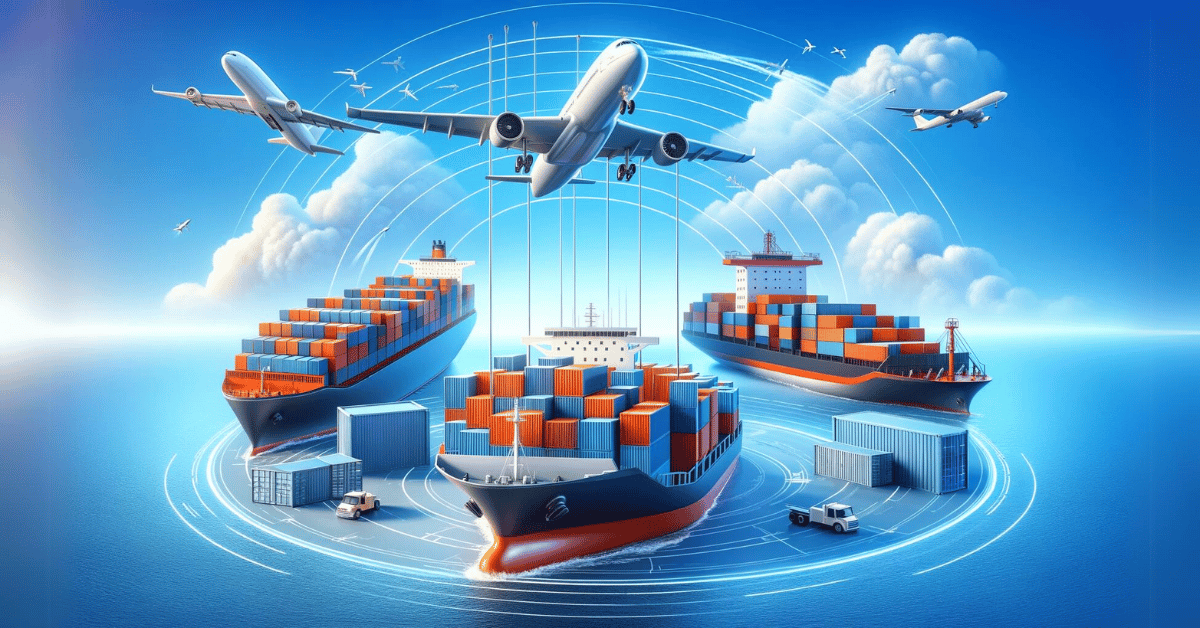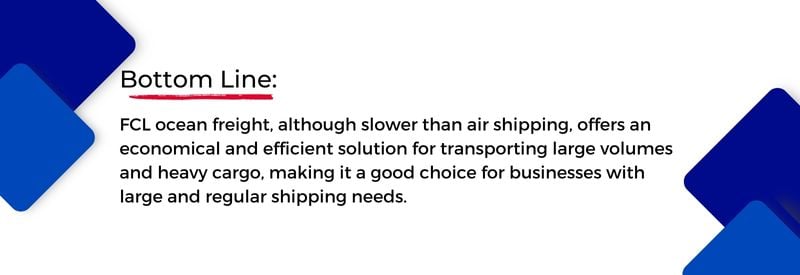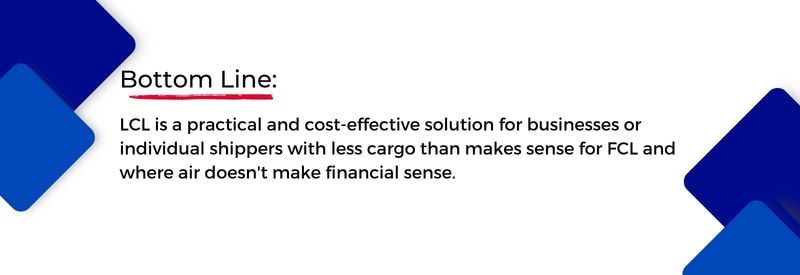
Comparing Air and Ocean Freight: Key Differences in International Shipping
Choosing the most suitable mode of freight shipping can seem like navigating a labyrinth of decisions, each with its own set of advantages and challenges. Whether it's air, ocean, or less-than-container load (LCL), the choice you make can drastically impact your business's efficiency, cost, and environmental footprint.
While method each has its advantages and disadvantages, air freight seems to be a method that draws the most questions, so let's delve into the world of air freight and uncover the advantages and caveats it holds for your shipping needs, and then move into ocean freight.
Air Freight: Operations, Advantages, and Disadvantages
Air freight, involving the transportation of goods via air carriers, stands out for its rapid and efficient delivery, especially over long distances. It's adaptable, accommodating everything from small personal items to large industrial machinery. Ideal for urgent shipments, it ensures fast delivery, often within days, irrespective of distance.
Purpose and Cost
In the global economy, businesses and consumers increasingly rely on air freight for logistics. The surge in e-commerce has particularly heightened this demand, with online retailers needing swift deliveries worldwide. Critical sectors like pharmaceuticals and perishable goods also depend on it for quick, temperature-controlled transport; It's particularly suited for high-value, low-volume shipments, aiding in inventory control and reducing overstock and shortages. While more costly than ocean or land options, its speed and reliability are unparalleled, making it an essential part of modern logistics.
To make it possible, a network of airlines, cargo carriers, and operators work together to ensure swift global transport. As a result, air freight has extensive reach to cover areas not easily accessible by other transport modes. Without a doubt, it's a miracle of a modern age. However, air freight isn't without drawbacks. Its high cost can be prohibitive for small businesses or low-margin goods.
The increased cost of air freight comes down to a few key factors:
- Aircraft are expensive to operate, with high fuel costs and significant maintenance requirements.
- Air freight requires a large network of resources. Airports, ground handling, terminals for drayage out, etc. Unlike a port where one place can be built to handle scale, air networks are often smaller than their ocean counterparts, handling smaller loads. This reduced economies of scale makes it more expensive.
- Strict regulations and security measures associated with aviation increase overall costs due to necessary compliance efforts. And it's for good reason. If an ocean liner loses power or engines, it can float until it's recovered. If a plane loses engines, it's catastrophic.
Pros and Cons
In all, the speed and efficiency of air freight come at a premium, with businesses willing to pay higher rates for faster delivery. However, drawbacks don't stop there: it's also less suitable for bulky or oddly shaped items that don't fit aircraft constraints. These constraints are primarily related to the size and weight of the cargo, which must fit within the dimensions of the aircraft's cargo hold and not exceed its weight limits. For instance, an item like a large piece of machinery or a grand piano may be too bulky, or an extremely heavy industrial component may exceed the plane's weight capacity.
Furthermore, items with irregular shapes might not be efficiently accommodated in the aircraft's hold, which is designed to maximize space utilization with cargo of regular, cubic shapes. For example, a large statue or an oddly shaped piece of art may not fit well, as these items can't be stacked or arranged efficiently, taking up more space than they should in comparison to their weight.
Furthermore, the loading and unloading mechanisms and equipment have their own limitations. They are designed to handle cargo of specific sizes and shapes. Non-standard items might require special handling which increases the costs and complexity of air freight. These factors collectively make air freight a less suitable option for bulky, heavy, or irregularly shaped items.

Ocean Freight: Exploring Full-Container Load (FCL) and Less-than-Container Load (LCL) Shipping Options
As we venture away from the skies and dive into the world of ocean freight, a different set of dynamics comes into play in our logistical chessboard. Despite air freight's speed, ocean freight remains a stalwart in the shipping industry, carrying the heavy lifting of global commerce on its waves. Renowned for its cost-effectiveness and large-volume capacity, ocean freight harnesses the vast expanse of the world's seas to transport goods from one continent to another. This mode of transportation is not without its unique challenges and complexities, but it holds undeniable significance in the global supply chain, especially for bulkier, heavier cargo. Let's set sail and navigate the sprawling world of ocean freight.
There are 2 ways of shipping ocean: FCL(Full Container Load) or LCL (Less Than Container Load). Let's dive into these common ways of shipping, to see their differences, pros and cons.
Full-Container Load (FCL) Ocean Freight
When it comes to shipping your cargo, everything will be containerized to ensure that each cargo ship can maximize the cargo it carries. Because there aren't as many cargo ships as you might think there would be, and optimization ensures the fastest possible logistics.
The pricing of Full Container Load (FCL) ocean freight is determined by a variety of factors. Primarily, the cost hinges on the shipping route, which considers the distance between the origin and destination ports. Longer routes typically entail higher costs. In addition, the size of the container significantly influences the price, with larger containers incurring greater expenses. The type and weight of the goods being shipped also play a role, as certain commodities may require special handling or equipment, resulting in additional charges. Market demand is another key determinant; during peak seasons, when the demand for containers outstrips supply, prices tend to rise. Furthermore, costs can also be affected by external factors such as fuel prices and surcharges levied by shipping lines for factors like currency adjustments and security measures.
The containers you might select come in various sizes commonly used in international ocean freight transportation:
- 20STD: also known as a 20-foot Standard, is a fundamental measure in ocean freight, referring to a common type of shipping container that is 20 feet long, 8 feet wide, and 8.5 feet high, providing an efficient vessel for transporting various goods globally.
- 40STD: also referred to as a 40-foot Standard, is another common type of shipping container in ocean freight, offering double the length of the 20STD, thus providing an increased capacity for transporting larger volumes of goods effectively across global routes.
- 40HC: standing for a 40-foot High Cube, is a variant of the standard shipping container, offering an extra foot in height, thus allowing for more cargo space and better accommodation of taller items, making it a favored choice in ocean logistics when dealing with voluminous goods
Additionally, there are other types of containers available, including 45HC, open-top, and flat racks. These different container options cater to different cargo needs and provide flexibility in transporting goods across the globe.

Less-than-Container Load (LCL) Ocean Freight
LCL (Less than Container Load) ocean freight is a strategy that allows multiple shippers to share a container's cost and space. It's ideal for small businesses or individual shippers with cargo volumes insufficient to fill an entire container. In LCL, smaller shipments from different shippers are consolidated into one container, making it a cost-effective solution for smaller cargo loads.
The pricing of LCL is typically based on the volume of space occupied by the cargo, measured in cubic meters or feet. This approach ensures shippers pay only for the space their goods use. However, additional charges like handling, transportation, and clearance are proportionally divided among shippers according to their cargo's space. Factors influencing LCL pricing include the type of goods, their value, shipping route, and market demand.
When comparing LCL with FCL (Full Container Load), the choice depends on the cargo volume. FCL is more efficient for large volumes, bypassing the consolidation and deconsolidation processes that LCL requires. LCL, while slower due to these additional steps, offers flexibility, allowing for frequent shipments of smaller volumes and better inventory management without the need for large storage space.
LCL's advantages include cost savings for smaller shipments and inventory flexibility. Its drawbacks are increased handling, which can raise the risk of damage, and longer shipping times due to consolidation. Conversely, FCL, more suitable for larger shipments, can be less efficient if the container isn't fully utilized. In some cases, shipping a partially filled FCL can be more cost-effective than opting for LCL.
Which international shipping method is right for you?
Both air and ocean freight come with their distinct sets of advantages and disadvantages, and the choice largely depends on the specific needs of the shippers. Air freight is characterized by its speed and efficiency, making it the perfect choice for time-sensitive cargo. However, due to size and weight constraints, it may not be the ideal method for transporting larger and heavier goods. On the other hand, ocean freight, while slower, is lauded for its cost-effectiveness and large-volume capacity. It is ideally suited for the transportation of larger, heavier cargo, with options for Full Container Load (FCL) and Less Than Container Load (LCL) further offering flexibility based on the size and volume of the goods.
Ultimately, shippers must factor in their goods, the urgency of delivery, and their budgets when selecting the most suitable shipping method. Shippers with smaller cargo volumes that aren't time-sensitive might find the cost-effectiveness and shared space of LCL ocean freight most appealing. Conversely, those with large volumes of goods or a tight delivery schedule might prefer the speed of air freight or the large volume capacity of FCL. The choice between air and ocean freight, and further between FCL and LCL, should be a strategic decision, keeping in mind the balance between cost, time, and cargo characteristics.
